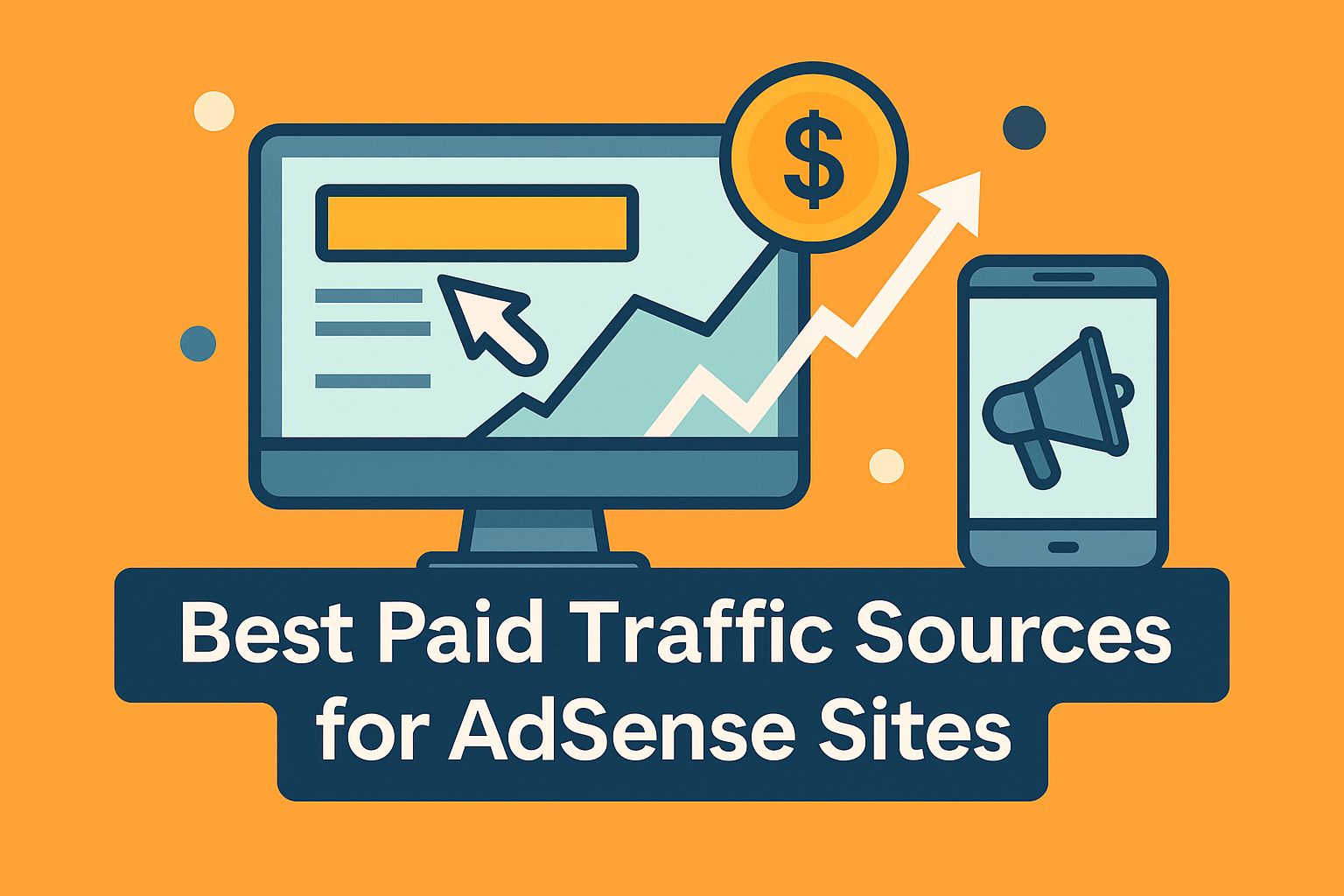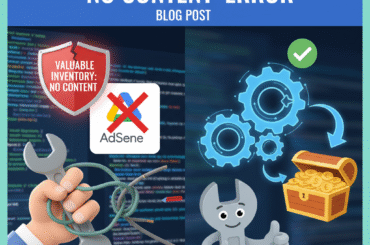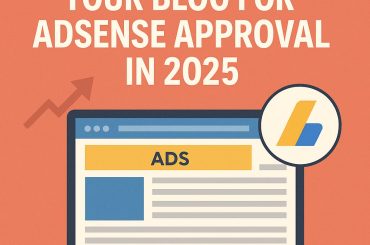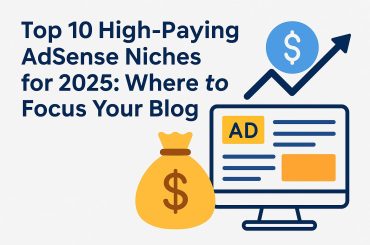Best Paid Traffic Sources for AdSense Sites
For website owners and digital marketers leveraging Google AdSense to monetize their content, driving high-quality, targeted traffic is critical to maximizing revenue. While organic traffic through search engine optimization (SEO) is valuable, paid traffic sources can provide a faster and more controlled way to scale your AdSense earnings. However, not all paid traffic sources are created equal. Choosing the right platforms and strategies can make the difference between a profitable campaign and wasted ad spend. In this comprehensive guide, we’ll explore the best paid traffic sources for AdSense sites, their benefits, drawbacks, and tips for optimization to ensure compliance with Google’s policies and maximize your return on investment (ROI).
Why Paid Traffic for AdSense Sites?
Paid traffic allows you to drive targeted visitors to your AdSense site quickly, bypassing the slower process of organic growth. When used correctly, paid traffic can:
- Increase Ad Impressions: More visitors mean more opportunities for ad clicks and revenue.
- Target Specific Audiences: Paid platforms allow precise targeting based on demographics, interests, and behavior.
- Scale Earnings: Rapid traffic growth can lead to exponential increases in AdSense revenue.
- Test Content Performance: Paid traffic helps you test which pages or niches generate the most clicks and revenue.
However, AdSense has strict policies regarding traffic quality. Using low-quality or invalid traffic sources (e.g., bots or incentivized clicks) can lead to account suspension. Therefore, it’s crucial to focus on high-quality, legitimate traffic sources that align with Google’s guidelines.
Key Considerations for Choosing Paid Traffic Sources
Before diving into the best paid traffic sources, consider the following factors to ensure success:
- AdSense Compliance: Avoid traffic sources that encourage fake clicks, use bots, or violate Google’s policies.
- Cost-Effectiveness: Your cost per click (CPC) or cost per thousand impressions (CPM) should be lower than your AdSense earnings per visitor.
- Targeting Options: Choose platforms that allow precise targeting to attract relevant visitors who are likely to engage with your ads.
- Traffic Quality: Prioritize sources that deliver real, engaged users rather than low-quality traffic that bounces quickly.
- Scalability: The platform should allow you to scale campaigns as your budget and revenue grow.
With these factors in mind, let’s explore the best paid traffic sources for AdSense sites in 2025.
1. Google Ads
Overview
Google Ads is the most reliable and AdSense-friendly paid traffic source, as it’s part of the same ecosystem. It offers a variety of ad formats, including search ads, display ads, and video ads on YouTube, making it versatile for driving traffic to AdSense sites.
Why It’s Great for AdSense Sites
- High-Quality Traffic: Google Ads delivers real users who are actively searching for or interested in your niche.
- Precise Targeting: Use keywords, demographics, interests, and remarketing to attract relevant visitors.
- AdSense Compliance: Since Google owns both platforms, traffic from Google Ads is fully compliant with AdSense policies.
- Scalability: With a massive reach, you can scale campaigns to drive thousands of visitors daily.
Best Practices
- Focus on Search Ads: Target high-intent keywords related to your niche to attract users likely to engage with your content and ads.
- Use Display Ads for Scale: Display ads are cheaper and great for building awareness, but ensure your landing pages are optimized for engagement.
- Leverage Remarketing: Retarget visitors who previously engaged with your site to increase ad impressions and clicks.
- Optimize Landing Pages: Ensure your site is fast, mobile-friendly, and has relevant content to reduce bounce rates and improve AdSense earnings.
- Monitor CPC: Keep your cost per click lower than your estimated earnings per click (EPC) from AdSense.
Drawbacks
- High Costs: Competitive keywords can have high CPCs, requiring careful budget management.
- Learning Curve: Effective campaign setup requires knowledge of keyword research and bid strategies.
Example Strategy
For a tech blog with AdSense, use Google Ads to target keywords like “best laptops 2025” or “smartphone reviews.” Create compelling ad copy and direct users to high-performing content pages with multiple ad placements.
2. Microsoft Advertising (Bing Ads)
Overview
Microsoft Advertising, formerly Bing Ads, is a lesser-known but effective alternative to Google Ads. It serves ads on Bing, Yahoo, and partner sites, offering a similar pay-per-click (PPC) model with potentially lower costs.
Why It’s Great for AdSense Sites
- Lower Competition: Bing has less competition than Google, resulting in lower CPCs for many niches.
- Quality Traffic: Users on Bing are often searching for information or products, making them likely to engage with your content.
- AdSense Compliance: Traffic from Microsoft Advertising is legitimate and safe for AdSense sites.
- Similar Features to Google Ads: Offers keyword targeting, display ads, and audience segmentation.
Best Practices
- Target Niche Keywords: Focus on long-tail keywords with lower competition to maximize ROI.
- Use Audience Targeting: Leverage Microsoft’s in-market audiences to reach users interested in your niche.
- Test Different Ad Formats: Experiment with search and display ads to find the best-performing combination.
- Track Conversions: Use Microsoft’s tracking tools to monitor which campaigns drive the most engaged visitors.
Drawbacks
- Smaller Reach: Bing’s market share is smaller than Google’s, limiting scalability.
- Less Advanced Features: Microsoft Advertising has fewer targeting options compared to Google Ads.
Example Strategy
For a finance blog, use Microsoft Advertising to target keywords like “personal finance tips” or “best savings accounts.” Direct traffic to well-optimized content pages with high-paying finance-related ads.
3. Facebook Ads
Overview
Facebook Ads (via Meta’s ad platform) is a powerful tool for driving targeted traffic through social media. With billions of users, it offers unparalleled audience targeting and a variety of ad formats, including image, video, and carousel ads.
Why It’s Great for AdSense Sites
- Advanced Targeting: Target users based on interests, behaviors, demographics, and lookalike audiences.
- Cost-Effective: CPCs and CPMs are often lower than Google Ads, especially for niche audiences.
- Engaging Ad Formats: Visual ads can attract users to click through to your site.
- Retargeting Options: Use the Facebook Pixel to retarget users who previously visited your site.
Best Practices
- Create Engaging Ads: Use eye-catching visuals and compelling copy to drive clicks.
- Target Relevant Interests: For example, target “health and wellness” enthusiasts for a fitness blog.
- Optimize for Mobile: Most Facebook users are on mobile, so ensure your site is mobile-optimized.
- Avoid Clickbait: Ensure your ads and landing pages comply with AdSense policies to avoid penalties.
- Monitor Engagement Metrics: Focus on campaigns that drive low bounce rates and high time-on-site.
Drawbacks
- Lower Intent: Social media users may not be as search-focused as Google Ads users, potentially leading to lower engagement.
- Policy Risks: Misleading ads or low-quality landing pages can lead to AdSense violations.
Example Strategy
For a travel blog, create a carousel ad showcasing “Top 10 Destinations for 2025” and target users interested in travel. Direct clicks to a content page with AdSense ads optimized for travel-related keywords.
4. Native Advertising Platforms (Taboola, Outbrain)
Overview
Native ad platforms like Taboola and Outbrain serve ads that blend seamlessly with content on publisher sites, such as news outlets or blogs. These ads appear as “recommended articles” or “sponsored content.”
Why It’s Great for AdSense Sites
- High Engagement: Native ads feel less intrusive, leading to higher click-through rates (CTRs).
- Cost-Effective: CPMs are often lower than traditional display ads, making it affordable for scaling traffic.
- Wide Reach: These platforms partner with major publishers, ensuring access to large audiences.
- AdSense Compliance: When used correctly, native ads deliver legitimate traffic that aligns with Google’s policies.
Best Practices
- Create Compelling Headlines: Use curiosity-driven headlines (without clickbait) to attract clicks.
- Target Relevant Audiences: Use platform targeting options to reach users interested in your niche.
- Optimize Landing Pages: Ensure your content is engaging and keeps visitors on the page to maximize ad impressions.
- Test Multiple Creatives: Run A/B tests to identify the best-performing ads.
Drawbacks
- Lower Intent: Users clicking native ads may not be as targeted as search traffic.
- Quality Control: Some native ad traffic may have higher bounce rates if not optimized properly.
Example Strategy
For a lifestyle blog, use Taboola to promote an article like “10 Life Hacks You’ll Wish You Knew Sooner.” Target users interested in self-improvement and direct them to a page with strategically placed AdSense ads.
5. YouTube Ads
Overview
YouTube Ads, powered by Google Ads, allow you to run video or display ads on the world’s largest video platform. They’re ideal for driving traffic to content-heavy AdSense sites.
Why It’s Great for AdSense Sites
- Engaging Format: Video ads can capture attention and drive clicks to your site.
- Massive Reach: YouTube’s billions of users offer scalability for traffic campaigns.
- Targeting Options: Target by interests, demographics, or specific video content.
- AdSense Compliance: As part of Google’s ecosystem, YouTube Ads are safe for AdSense sites.
Best Practices
- Create Short, Engaging Videos: Keep ads under 30 seconds to maintain viewer interest.
- Use In-Stream Ads: Place skippable or non-skippable ads before relevant videos to drive traffic.
- Target Niche Audiences: For example, target “DIY enthusiasts” for a home improvement blog.
- Include Clear CTAs: Encourage viewers to visit your site for more information.
Drawbacks
- Higher Costs: Video ad production and CPCs can be more expensive than text-based ads.
- Requires Video Content: You’ll need to create or outsource video ads, which adds complexity.
Example Strategy
For a tech blog, create a 15-second ad showcasing “The Future of Smartphones” and target tech enthusiasts. Link to a blog post with AdSense ads optimized for tech-related keywords.
6. TikTok Ads
Overview
TikTok Ads have exploded in popularity, offering a unique way to reach younger audiences through short, engaging video ads. The platform is ideal for viral content and niche sites.
Why It’s Great for AdSense Sites
- High Engagement: TikTok’s algorithm drives massive engagement, leading to high CTRs.
- Affordable CPCs: Costs are often lower than other social platforms for similar audiences.
- Creative Freedom: TikTok’s informal style allows for fun, attention-grabbing ads.
- Growing User Base: TikTok’s massive audience offers scalability.
Best Practices
- Create Native-Style Ads: Ads that feel like organic TikTok content perform best.
- Target Younger Audiences: TikTok is popular with Gen Z and Millennials, so align your niche accordingly.
- Use Trends: Incorporate trending sounds or hashtags to boost ad visibility.
- Optimize for Mobile: Ensure your site loads quickly on mobile devices.
Drawbacks
- Niche Limitations: TikTok works best for lifestyle, entertainment, or youth-oriented niches.
- Policy Risks: Avoid overly promotional ads to stay compliant with AdSense.
Example Strategy
For a fashion blog, create a TikTok ad showcasing “Top Fall Fashion Trends” and target users interested in style. Direct traffic to a content page with AdSense ads.
Tips for Maximizing AdSense Revenue with Paid Traffic
- Track Performance: Use Google Analytics and AdSense reports to monitor traffic quality, bounce rates, and earnings.
- Optimize Ad Placements: Place ads in high-visibility areas (e.g., above the fold, within content) to increase clicks without violating AdSense policies.
- Focus on High-Paying Niches: Target niches like finance, insurance, or technology, which typically have higher CPCs in AdSense.
- Test and Iterate: Continuously test different traffic sources, ad creatives, and landing pages to find the most profitable combinations.
- Stay Compliant: Regularly review Google’s AdSense policies to ensure your traffic sources and ad strategies align with their guidelines.
Conclusion
Driving paid traffic to AdSense sites can significantly boost your revenue, but it requires careful selection of traffic sources and strategic optimization. Google Ads and Microsoft Advertising are ideal for high-intent, search-driven traffic, while Facebook Ads, Native Ads, YouTube Ads, and TikTok Ads offer cost-effective ways to reach engaged audiences. By focusing on quality traffic, precise targeting, and AdSense compliance, you can create profitable campaigns that scale your earnings.
Start small, test different platforms, and use analytics to refine your approach. With the right strategy, paid traffic can transform your AdSense site into a consistent revenue generator in 2025 and beyond.






